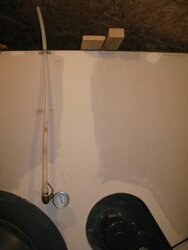Finally going to setup the new Garn controller. A few questions....
1. I assume my AC ground wire should go to the GROUND lug on the controller? Oddly enough, the little "manual" doesn't state this, nor that the power connection is under the black plastic shield. Obvious, I agree, but still....suprised.
2. Steve (heaterman) you mentioned in the past that Dectra was putting the temp sensor on the LWCO (low water cut off) shaft. Was that decision dropped? I have the LWCO I received with the Garn, and in the little manual, the sensor is placed in the well in the front of the unit. Now, my manual also says "backordered" digital units....so could it be that there is a different version with new shipping units with the temp sensor on the LWCO, located in the middle of the tank? Harry, was your sensor mounted to the LWCO or in the front? Quite certain I remember you had to drain a bit to get the new well in the front panel....?
There is quite a large difference between the sensors on the front of the Garn and the actual water temperature leaving the Garn....as has been discussed before in a few threads. Having a sensor in the middle, somewhat submerged I assume, would presumably be more accurate. I don't really care, it is just a calibration thing....I know that the front sensor will read quite a bit higher temp than the actual water supply....at least a few hours after the burn unti it starts to drop. In other words, temps agree after firing for awhile well, and then the divergence begins for many hours, and then finally once it gets down to 120 or so, they are close. I'm sure this is stratification happening, after the burn settles, and then finally it cools enough to agree again.
So, the question really about the sensor, could I get more heat into the storage if the sensor was placed in the middle and down a bit? Of course, becuase the temp there presumably would be a bit lower since it is deeper in the water...though while burning, stratification has to be somewhat minimal I'd think. I've been trying to hit the 190 target on the front sensor.
1. I assume my AC ground wire should go to the GROUND lug on the controller? Oddly enough, the little "manual" doesn't state this, nor that the power connection is under the black plastic shield. Obvious, I agree, but still....suprised.
2. Steve (heaterman) you mentioned in the past that Dectra was putting the temp sensor on the LWCO (low water cut off) shaft. Was that decision dropped? I have the LWCO I received with the Garn, and in the little manual, the sensor is placed in the well in the front of the unit. Now, my manual also says "backordered" digital units....so could it be that there is a different version with new shipping units with the temp sensor on the LWCO, located in the middle of the tank? Harry, was your sensor mounted to the LWCO or in the front? Quite certain I remember you had to drain a bit to get the new well in the front panel....?
There is quite a large difference between the sensors on the front of the Garn and the actual water temperature leaving the Garn....as has been discussed before in a few threads. Having a sensor in the middle, somewhat submerged I assume, would presumably be more accurate. I don't really care, it is just a calibration thing....I know that the front sensor will read quite a bit higher temp than the actual water supply....at least a few hours after the burn unti it starts to drop. In other words, temps agree after firing for awhile well, and then the divergence begins for many hours, and then finally once it gets down to 120 or so, they are close. I'm sure this is stratification happening, after the burn settles, and then finally it cools enough to agree again.
So, the question really about the sensor, could I get more heat into the storage if the sensor was placed in the middle and down a bit? Of course, becuase the temp there presumably would be a bit lower since it is deeper in the water...though while burning, stratification has to be somewhat minimal I'd think. I've been trying to hit the 190 target on the front sensor.




